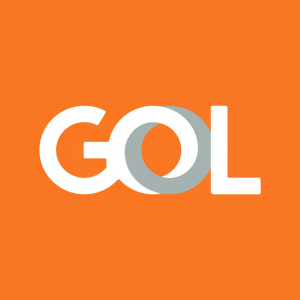GOL announces 1Q24 EARNINGS RESULTS
Rhea-AI Summary
GOL Linhas Aéreas Inteligentes (NYSE: GOL) announced its 1Q24 earnings results, highlighting a 30.3% recurring EBITDA margin, a 5.1 percentage point increase from 1Q23. Net operating revenue was R$4.7 billion, a 4.2% decline year-over-year. GOL filed for Chapter 11 in the US to restructure its balance sheet, securing US$1 billion in debtor-in-possession financing, with US$550 million drawn by 1Q24's end. Cash reserves rose to R$2.0 billion, a 150% increase from 1Q23. Despite a 5.3% reduction in recurring CASK, ex-fuel CASK rose 8.9%. Net leverage decreased to 4.0x, down from 6.0x in 1Q23. Adjusted net loss stood at R$130 million. Operational improvements included a 1.7% increase in aircraft utilization and a stable load factor of 83.1%.
Positive
- Recurring EBITDA margin improved to 30.3%, a 5.1 percentage point increase from 1Q23.
- Cash reserves increased by 150% year-over-year to R$2.0 billion.
- Net leverage decreased to 4.0x from 6.0x in 1Q23.
- International RPK increased by 39.6% compared to 1Q23.
- Load factor remained stable at 83.1%, with international load factor improving by 7.8% to 85.6%.
- Operational aircraft utilization rose by 1.7% to 11.9 hours per day.
Negative
- Net operating revenue declined by 4.2% year-over-year to R$4.7 billion.
- Total passengers carried decreased by 8.3% to 7.3 million.
- Recurring Cost per Seat Kilometer excluding fuel costs increased by 8.9% to 22.44 cents (R$).
- Adjusted net loss was R$130 million, excluding significant exchange rate and derivative impacts.
- Average yield per passenger decreased by 0.7% to 48.2 cents (R$).
- Total Revenue Passenger Kilometers (RPK) dropped by 4.1%.
Insights
GOL's first quarter earnings report provides a comprehensive view into the company's financial health and operational performance. The company reported a net operating revenue of R$4.7 billion, which is a 4.2% decrease compared to the same period last year. However, a significant improvement can be seen in the recurring EBITDA margin, which increased to 30.3%, up by 5.1 percentage points. This indicates stronger operational efficiency and cost management despite the revenue decline.
GOL's filing for Chapter 11 bankruptcy to restructure its balance sheet is a critical point. This move can have mixed implications. On one hand, the US$1 billion debtor-in-possession loan financing (DIP Loan) provides liquidity, allowing operations to continue smoothly. On the other hand, investors might perceive the bankruptcy filing as a sign of financial distress.
Moreover, the company's net leverage ratio improved, decreasing to 4.0x from 6.0x, demonstrating significant progress in debt management. However, the adjusted net loss of R$130 million, despite excluding certain non-recurring costs, remains a concern.
For retail investors, it’s important to note the reduced recurring Cost per Seat Kilometer (CASK) by 5.3% due to lower fuel prices, which is a positive sign. However, the increase in CASK excluding fuel and non-recurring items (8.9%) suggests that other operational costs have risen significantly.
Short-term implications: The short-term outlook appears cautiously optimistic due to the liquidity provided by the DIP loan and operational efficiencies. However, the bankruptcy restructuring process introduces significant uncertainty.
Long-term implications: The successful restructuring of GOL’s financial obligations could lead to a stronger financial position and improved investor confidence. However, this depends on the company's ability to sustain operational improvements and manage costs effectively amidst competitive pressures in the airline industry.
GOL's performance reflects several market dynamics and strategic decisions. The significant increase in international Revenue Passenger Kilometers (RPK) by 39.6% suggests a strategic pivot towards more profitable international routes, likely driven by favorable market conditions and potentially higher yields compared to domestic routes where RPK decreased by 4.1%.
The stable load factor of 83.1% with a notable boost in international load factor (up by 7.8%) indicates effective yield management and efficiency in capacity utilization. GOL’s focus on renewing its fleet with more fuel-efficient Boeing 737 MAX-8 aircraft aligns with industry trends towards sustainability and cost efficiency.
Additionally, the company's effort in maintaining a single fleet model underscores its commitment to operational simplicity and cost reduction. The operational aircraft utilization rate of 11.9 hours per day is also an indicator of optimal asset utilization, which is important for profitability in the airline industry.
However, the decrease in total passengers carried by 8.3% and a reduction in average yield per passenger by 0.7% highlight some underlying challenges, possibly due to a competitive domestic market and fluctuating demand patterns.
Short-term implications: GOL’s strategic focus on international routes and operational efficiencies should help mitigate some revenue pressures, although the domestic market remains challenging.
Long-term implications: If GOL can successfully navigate its financial restructuring and continue optimizing its fleet and routes, it could strengthen its competitive position. Market share expansion in international routes can provide growth opportunities, but the company must balance this with managing domestic market challenges effectively.
From a legal perspective, GOL’s Chapter 11 filing in the United States is a significant move aimed at restructuring its debt and ensuring long-term viability. The Chapter 11 process allows GOL to reorganize its debts under the supervision of the court, which can provide a framework for renegotiating terms with creditors, lessors and other stakeholders.
The US$1 billion DIP Loan Commitments offer GOL the necessary liquidity to maintain operations during the restructuring. However, this comes with stringent conditions and oversight by the court and creditors, which could impact the company’s autonomy in decision-making. It’s important to monitor the progress of this restructuring to assess whether GOL can emerge as a more financially stable entity.
For investors, the Chapter 11 filing might initially raise concerns about the company's solvency. However, if managed well, it can result in a stronger balance sheet and improved financial health. The ability to restructure leases and other obligations is particularly important in the airline industry, known for its capital-intensive nature and high operational costs.
Short-term implications: The legal restructuring process under Chapter 11 is expected to involve detailed negotiations and possible litigation, which can create volatility and uncertainty for investors.
Long-term implications: Successfully exiting Chapter 11 with a restructured balance sheet can provide a solid foundation for GOL’s future growth. The outcome will largely depend on the company’s ability to renegotiate favorable terms with its creditors and lessors and effectively implement its reorganization plan.
SÃO PAULO, May 14, 2024 /PRNewswire/ -- GOL Linhas Aéreas Inteligentes S.A. ("GOL" or "Company") (NYSE: GOL and B3: GOLL4), one of the leading airlines in
All information in this release is presented in Reais (R$), in accordance with international accounting standards (IFRS) and with adjusted metrics, made available to enable comparison of this quarter with the same period of the previous year (1Q23). Adjusted (recurring) indicators exclude non-recurring expenses related to the quarter's results and are detailed in the respective tables.
1Q24 HIGHLIGHTS
- The Company's recurring EBITDA margin in 1Q24 was
30.3% , an improvement of 5.1 p.p. compared to the same period of the previous year; - Net operating revenue was
R in 1Q24;$4.7 billion - On January 25th, the Company filed for Chapter 11 in
United States to restructure its balance sheet and enhance its capabilities to remain one of the leading airlines inBrazil ; - GOL secured a total of
US of "debtor-in-possession" loan financing (the "DIP Loan Commitments"), of which$1.0 billion US was funded by the end of 1Q24. Since the end of the 1Q24. GOL has fully drawn the remaining$550 million US of DIP Loan Commitments;$450 million - Cash increased to
R ,$2.0 billion 150% higher than the end of 1Q23 (R ) due to the initial DIP Loan financing funded in 1Q24 (which excluded the undrawn$0.8 billion US of DIP Loan Commitments) and Accounts Receivable increased to$450 million R , twice the 1Q23's amount ($2.0 billion R ) as a result of lower receivables factoring;$1.0 billion - Recurring CASK reduced by
5.3% when compared to 1Q23 due to decrease in fuel price. Recurring CASK ex-fuel increased by8.9% due to the return of one Boeing 737 NG aircraft and delivery of two new Boeing 737 MAX-8 in the quarter, in addition to non-recurring financial restructuring costs within the context of Chapter 11; - Net leverage³ reached 4.0x, 2.0x lower than 1Q23;
- During 1Q24, the Company received two new Boeing 737 MAX-8 and returned one Boeing 737 NG as part of its fleet renewal process.
CEO COMMENTS
Celso Ferrer, Chief Executive Officer, commented: "The first quarter of 2024 was marked by the improvement on our operational performance, with Adjusted EBITDA for 1Q, at
SUMMARY OF THE FIRST QUARTER 2024 RESULTS (VS. 1Q23)
- The number of international Revenue Passenger Kilometers (RPK) increased by
39.6% compared to 1Q23, with total RPK decreasing by4.1% in the same period, in line with our investment in the international services; - Total international Seat Kilometers Offered (ASK) increased by
27.0% compared to 1Q23, while total ASK decreased by3.9% in the same period given domestic market conditions; - Net Operating Revenue decreased
4.2% toR ;$4.7 billion - Load factor remained stable and reached
83.1% , a0.2% improvement compared to 1Q23. Domestic load factor decreased1.3% to82.7% , while International load factor improved7.8% to85.6% ; - Operational aircraft utilization increased by
1.7% to 11.9 hours per day; - Total passengers carried decreased by
8.3% , to 7.3 million; - Net Revenue per Seat Kilometer Offered (RASK) decreased
0.3% to43.7 cents (R$); - Average yield per passenger reduced
0.7% , to48.2 cents (R$); - Recurring Cost Per Seat Kilometer (CASK) is down
5.3% at34.44 cents (R$), due in most part to lower fuel prices and lower consumption per ASK (0.9% ) driven by our growth on international routes; - Cost Per Seat Kilometer excluding fuel costs and non-recurring items (CASK Ex-fuel) increased
8.9% to22.44 cents (R$) compared to 1Q23; - Recurring EBITDA was
R with a$1.4 billion 30.3% margin, while recurring EBIT wasR with a$1.0 billion 21.2% margin; - Adjusted net loss was
R , excluding the effects of the exchange rate variation and the mark-to-market of the ESSN derivative component, which represented$ 130 million R in the 1Q24;$3.9 billion - Adjusted net debt to LTM recurring EBITDA was 4.0x on 1Q24, a reduction of 2.0x compared to 1Q23.
FULL EARNINGS RELEASE & PRESENTATION
Access the earnings release, presentation and full financial statements at: www.voegol.com.br/ir
Investor Relations: ir@voegol.com.br
About GOL Linhas Aéreas Inteligentes S.A.
GOL is a leading domestic airline in
![]() View original content:https://www.prnewswire.com/news-releases/gol-announces-1q24-earnings-results-302145042.html
View original content:https://www.prnewswire.com/news-releases/gol-announces-1q24-earnings-results-302145042.html
SOURCE GOL Linhas Aéreas Inteligentes S.A.









